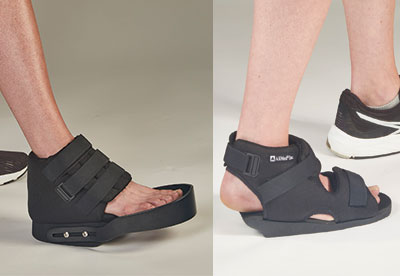-
Home
-
Are offloading shoes the right fit for your patient’s foot condition?
Are offloading shoes the right fit for your patient’s foot condition?
February 4, 2022

Foot conditions such as ulcers, neuropathy, peripheral arterial disease, foot deformity, and other acute foot trauma are common in older patients, particularly those with diabetes. In fact, about 15% of patients diagnosed with diabetes develop foot ulcers.
These types of injuries, while ranging in severity, are often debilitating as they limit or prevent a patient’s ambulation and sometimes can be slow to heal. This is especially true in diabetic patients, for whom wound healing and mobility may already be compromised. As a result, there is no one-size-fits-all treatment plan for these conditions.
Regardless of the specific case, podiatric postoperative or wound care usually requires patients to avoid putting pressure on the afflicted area to promote healing and prevent issues such as pain, swelling, or further complications.
This is often accomplished through non-weight-bearing or offloading devices, which should be chosen based on the type and severity of the condition as well as factors such as peripheral edema, wound location, ambulation needs, or wound monitoring and care requirements.
Non-weight-bearing or offloading?
Non-weight-bearing devices such as wheelchairs, crutches, or knee walkers remove pressure completely from the injured foot, preventing the foot from ever coming in contact with the ground. While this fully achieves the goal of offloading, these devices are often impractical due to expense, difficulty of use, fall risk, obesity, or the type of condition being treated. For example, because non-weight-bearing devices limit or prohibit ambulation, they may not be appropriate for patients with less severe cases.
Total contact casts (TCCs), walker boots, and other offloading devices work by transferring pressure away from the wound to a different area of the foot, allowing for limited ambulation during recovery. Nonremovable TCCs have been the traditional solution for offloading pressure from a foot wound, but they are often expensive, need to be customized, or are poorly tolerated by patients. Other factors can prohibit the use of nonremovable TCCs, including poor skin quality or the presence of wounds that require more continuous care.
If the shoe fits, prescribe it!
Offloading shoes, such as AliMed’s Open Heel and Open Forefoot Orthoses, can accomplish the same goals as more expensive or cumbersome devices but are lighter, more affordable, and easily removable for more convenient access to the wound, helping ensure proper healing and reducing the risk of recurrence.
Offloading shoes may also promote greater patient independence than other devices, resulting in overall higher compliance and a more successful recovery process. In addition to the general benefits of offloading shoes, AliMed’s Open Heel and Forefoot Orthoses feature lightweight nonslip outsoles for greater stability, specific straps for easier application and better fit, and a soft, seamless inner lining for added patient comfort at a more affordable price point.
Proper usage and additional support
With any postoperative or wound care device, proper usage is imperative to ensure its effectiveness. When using an offloading shoe, patients tend to shift their weight too far forward or backward, increasing pressure on the forefoot or heel and slowing down or even working against the healing process. Therefore, understanding how to walk correctly when using these devices is essential. AliMed has developed an instructional video on proper ambulation as an easy-to-use resource for better patient outcomes—watch it here!
Additionally, a patient’s successful recovery involves more than just treating the wounded area, especially in the case of foot trauma. Complementary devices, such as heel lifts, insoles, or inserts, can offset temporary leg-length discrepancy caused by an orthosis, allowing for easier ambulation and helping reduce hip or back pain.
Starting recovery on the right foot
Once you’ve determined the type of device needed for your patient’s unique situation, you’ll need the correct tools to start their recovery on the right foot—and keep it on track. As a trusted partner in healthcare, AliMed has a long history of providing footcare solutions, with a full suite of products to help you find the perfect fit for every patient.